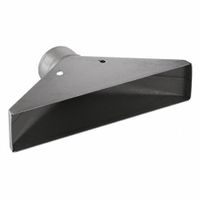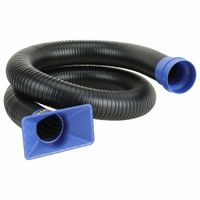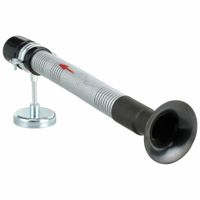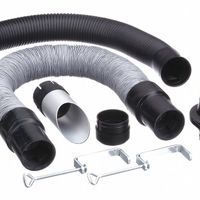Call +(254) 703 030 000 / 751 483 999 / 721 704 777
- Home
- Welding
- Welding Soldering Fume Extraction
- Fume Extractor Hoses Nozzles
.....Read More
Frequently Asked Questions
What materials are hoses and nozzles for fume extractors made of?
Hoses and nozzles for fume extractors are typically made from materials that can withstand high temperatures, corrosive substances, and mechanical wear. Common materials include:
1. **Flexible Hoses:**
- **Polyurethane (PU):** Known for its flexibility, abrasion resistance, and durability, PU is often used for hoses that need to be lightweight and easy to maneuver.
- **Polyvinyl Chloride (PVC):** Offers good chemical resistance and is cost-effective, making it suitable for general-purpose fume extraction.
- **Neoprene:** Provides excellent resistance to oils, chemicals, and heat, making it ideal for industrial environments.
- **Silicone:** Used for high-temperature applications due to its excellent heat resistance and flexibility.
- **EPDM (Ethylene Propylene Diene Monomer):** Known for its resistance to heat, ozone, and weathering, suitable for outdoor and high-temperature applications.
2. **Nozzles:**
- **Stainless Steel:** Offers excellent corrosion resistance and durability, suitable for harsh industrial environments.
- **Aluminum:** Lightweight and resistant to corrosion, often used in applications where weight is a concern.
- **Plastic (e.g., ABS, Polypropylene):** Used for lightweight and cost-effective solutions, suitable for less demanding applications.
- **Brass:** Provides good corrosion resistance and durability, often used in applications requiring a robust material.
These materials are chosen based on the specific requirements of the fume extraction system, including the type of fumes being extracted, the temperature of the environment, and the need for flexibility or rigidity.
How do I determine the right size of hose and nozzle for my fume extractor?
To determine the right size of hose and nozzle for your fume extractor, consider the following factors:
1. **Airflow Requirements**: Identify the volume of air (measured in cubic feet per minute, CFM) that needs to be extracted. This depends on the type and intensity of the fumes being generated. Check the manufacturer's specifications for recommended CFM.
2. **Hose Diameter**: The hose diameter should match the CFM requirements. Larger diameters allow for higher airflow but may reduce suction power if the extractor's motor isn't powerful enough. Common diameters range from 2 to 6 inches. Use a larger diameter for higher CFM needs.
3. **Hose Length**: Longer hoses can reduce suction power due to increased resistance. Keep the hose as short as possible to maintain efficiency. If a long hose is necessary, consider increasing the diameter to compensate for the loss in suction.
4. **Nozzle Size and Shape**: The nozzle should be sized to effectively capture fumes at the source. A larger nozzle covers more area but may reduce suction strength. Choose a shape that suits the application, such as a flat nozzle for wide areas or a conical nozzle for concentrated sources.
5. **Material Compatibility**: Ensure the hose and nozzle materials are compatible with the fumes being extracted. Some materials may degrade or react with certain chemicals.
6. **Flexibility and Durability**: Consider the flexibility needed for maneuverability and the durability required for the working environment. Reinforced hoses may be necessary for harsh conditions.
7. **Regulatory Standards**: Check for any industry-specific regulations or standards that dictate hose and nozzle specifications for safety and compliance.
By evaluating these factors, you can select the appropriate hose and nozzle size to ensure efficient and safe fume extraction.
Are hoses and nozzles from different brands interchangeable?
Hoses and nozzles from different brands can be interchangeable, but compatibility depends on several factors. The primary consideration is the connection type and size. Most garden hoses and nozzles use standard fittings, such as the 3/4-inch GHT (Garden Hose Thread) in the United States, which allows for interchangeability across different brands. However, variations can exist, especially with international products that might use different standards like BSP (British Standard Pipe) or metric sizes.
Another factor is the material and design of the connectors. Some brands may use proprietary quick-connect systems or unique threading that may not be compatible with other brands. In such cases, adapters or converters might be necessary to ensure a proper fit.
The quality and durability of the materials used in hoses and nozzles can also affect interchangeability. High-quality brass or stainless steel fittings are generally more reliable and provide a better seal than plastic ones, which might wear out or cross-thread more easily.
Additionally, the intended use and pressure ratings of the hose and nozzle should be considered. A high-pressure nozzle may not be suitable for a lightweight hose, leading to potential damage or leaks.
In summary, while many hoses and nozzles from different brands are interchangeable due to standard sizing and threading, it is essential to verify compatibility by checking the connection type, material quality, and intended use. When in doubt, consulting product specifications or seeking advice from a knowledgeable retailer can help ensure a proper match.
How do I maintain and clean hoses and nozzles for optimal performance?
To maintain and clean hoses and nozzles for optimal performance, follow these steps:
1. **Regular Inspection**: Frequently check hoses and nozzles for signs of wear, cracks, or leaks. Replace any damaged parts immediately to prevent further issues.
2. **Proper Storage**: Store hoses coiled and off the ground to prevent kinks and damage. Use hose reels or hangers to maintain their shape and prolong their lifespan.
3. **Cleaning**: After each use, flush hoses with clean water to remove any debris or chemicals. For nozzles, soak them in a solution of water and mild detergent, then scrub with a soft brush to remove buildup.
4. **Drying**: Ensure hoses and nozzles are completely dry before storage to prevent mold and mildew. Hang them in a well-ventilated area or use a blower to speed up the drying process.
5. **Lubrication**: Apply a silicone-based lubricant to hose connections and nozzle threads to ensure smooth operation and prevent rust.
6. **Pressure Check**: Regularly check the pressure rating of hoses and nozzles to ensure they are suitable for your equipment. Using the wrong pressure can cause damage or reduce efficiency.
7. **Avoid Overstretching**: Do not pull hoses excessively or use them to drag equipment, as this can cause stretching and weakening.
8. **Temperature Considerations**: Avoid exposing hoses to extreme temperatures, which can cause material degradation. Use hoses rated for the specific temperature range of your application.
9. **Chemical Compatibility**: Ensure hoses and nozzles are compatible with the chemicals being used to prevent corrosion or damage.
10. **Professional Servicing**: Periodically have hoses and nozzles serviced by professionals to ensure they are in optimal condition and to address any issues that may not be visible.
By following these steps, you can maintain hoses and nozzles in good condition, ensuring their longevity and optimal performance.
What is the maximum temperature resistance for heat-resistant nozzles?
The maximum temperature resistance for heat-resistant nozzles varies depending on the material and design of the nozzle. Generally, heat-resistant nozzles are made from materials such as stainless steel, brass, or specialized high-temperature alloys like Inconel or ceramics, each offering different levels of thermal resistance.
1. **Stainless Steel Nozzles**: These are commonly used due to their durability and resistance to corrosion. They can typically withstand temperatures up to about 500°C (932°F).
2. **Brass Nozzles**: Brass nozzles are often used in applications where moderate heat resistance is required. They can generally handle temperatures up to around 300°C (572°F).
3. **Inconel Nozzles**: Inconel is a high-performance alloy known for its excellent resistance to extreme temperatures and corrosion. Nozzles made from Inconel can withstand temperatures up to approximately 1,000°C (1,832°F).
4. **Ceramic Nozzles**: These are used in applications requiring very high-temperature resistance. Ceramic nozzles can endure temperatures exceeding 1,200°C (2,192°F), making them suitable for use in environments like kilns or high-temperature industrial processes.
The choice of nozzle material depends on the specific application requirements, including the operating temperature, the presence of corrosive substances, and the mechanical stresses involved. It's crucial to select a nozzle that not only withstands the maximum temperature but also maintains its structural integrity and performance under those conditions.
How do I properly install hoses and nozzles on a fume extractor?
To properly install hoses and nozzles on a fume extractor, follow these steps:
1. **Safety First**: Ensure the fume extractor is powered off and unplugged. Wear appropriate personal protective equipment (PPE) such as gloves and safety goggles.
2. **Identify Components**: Familiarize yourself with the fume extractor's components, including the inlet port, hose, nozzle, and any clamps or connectors.
3. **Select the Right Hose and Nozzle**: Choose a hose and nozzle compatible with your fume extractor model. Ensure they are the correct size and material for the type of fumes being extracted.
4. **Attach the Hose**:
- Locate the inlet port on the fume extractor.
- Slide one end of the hose over the inlet port. If the hose is too tight, gently heat it with a hairdryer to make it more pliable.
- Secure the hose with a hose clamp. Tighten the clamp using a screwdriver to ensure a snug fit without over-tightening, which could damage the hose.
5. **Install the Nozzle**:
- Attach the nozzle to the other end of the hose. Ensure it fits securely.
- If the nozzle requires a clamp, use one to secure it in place.
6. **Position the Nozzle**:
- Adjust the nozzle to the optimal position for capturing fumes. It should be as close as possible to the source of the fumes without obstructing the work area.
7. **Test the System**:
- Plug in and power on the fume extractor.
- Check for any leaks or loose connections by feeling for air escaping around the hose and nozzle.
- Adjust as necessary to ensure efficient fume extraction.
8. **Regular Maintenance**: Periodically inspect the hose and nozzle for wear and tear, and replace them as needed to maintain optimal performance.
What are the signs that a hose or nozzle needs to be replaced?
Signs that a hose or nozzle needs replacement include:
1. **Visible Cracks or Splits**: Check for any visible damage such as cracks, splits, or holes in the hose or nozzle. These can lead to leaks and reduced efficiency.
2. **Leaks**: If water is leaking from areas other than the intended outlet, it indicates a problem. This could be due to worn-out seals or damage to the hose or nozzle.
3. **Reduced Water Pressure**: A noticeable drop in water pressure can be a sign of internal blockages or damage that restricts flow.
4. **Stiffness or Brittleness**: Over time, hoses can become stiff or brittle, especially if exposed to harsh weather conditions. This makes them more prone to cracking.
5. **Kinks or Twists**: Persistent kinks or twists that do not straighten out can impede water flow and indicate that the hose material has degraded.
6. **Rust or Corrosion**: For metal nozzles, rust or corrosion can weaken the structure and affect performance.
7. **Mold or Mildew**: The presence of mold or mildew, especially on the inside, can indicate that the hose is retaining moisture and not drying properly, which can lead to deterioration.
8. **Worn-out Fittings**: Check the fittings for signs of wear or damage. Loose or damaged fittings can cause leaks and may not connect properly.
9. **Age**: If the hose or nozzle is several years old, it may be time to replace it as materials can degrade over time, even if there are no visible signs of damage.
10. **Inconsistent Spray Patterns**: For nozzles, inconsistent or irregular spray patterns can indicate internal blockages or wear that affects performance.




